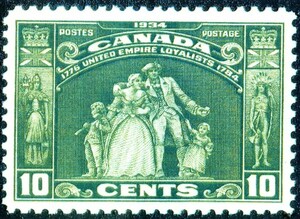STATUES

"The Loyalists....were the very cream of the population of the Thirteen Colonies. They represented in very large measure the learning, the piety, the gentle birth, the wealth and good citizenship of the British race in America, as well as its devotion to law and order, British institutions, and the unity of the Empire." (Henry Coyne, writing in 1904).
After the American Revolution, those who remained loyal to the British Crown were encouraged to resettle in Canada. This helped form a British backbone in lands which included earlier French settlers, new arrivals from Ireland and other "questionable" Europeans, plus thousands of Iroquois expelled from New York, and 3500 black Loyalists. In Hamilton, a monument was erected by Sydney March, portraying a lovely ideal Loyalist family, commemorated by a stamp of 1934. The stamp goes further than the statue, showing the protection of Britannia on the left, and the friendly Iroquois at right. Slavery was still legal in Canada, and families such as those depicted brought some 2000 black slaves with them. So, should the statue be torn down?
The import of further slaves was banned in Canada in 1793, and gradually those already there were emancipated, or encouraged to emigrate to Sierra Leone. The staunch work of Loyalist families in farming, trade, citizenship remains respected to this day.
Those who collect Commonwealth stamps will see a gradually changing range of images on the stamps - first, emblems of monarchy and sovereignty, then the economic advantages of colonialism (gold, tobacco, cattle, sugar, big game), and finally railways, schools, hospitals and natural wildlife.
A collection is a pathway filled with monuments of different ages, pauses for thought, every collection is a journey of understanding history, with its achievements as well as the darker currents. I think we are fortunate to have collections that offer such deep insights into history.
- Published
- 22/02/22 01:09:00 AM
